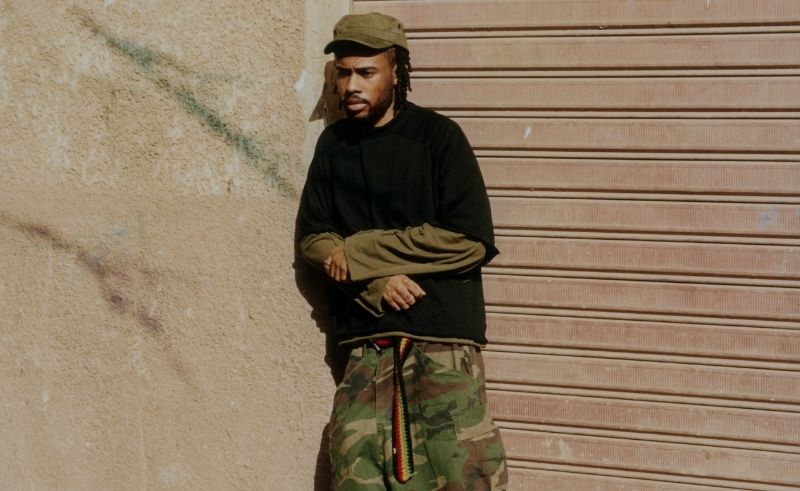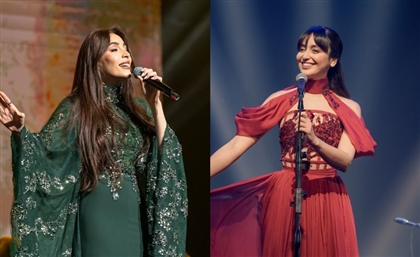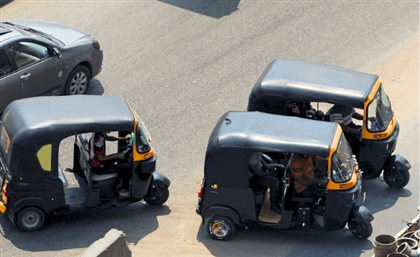Venna Builds Malik’s Visual World By Chasing the Light in Egypt
Sharing stories as film rolls, UK Photographers TJ Sawyerr & Elliot Hensford roam Fayoum sands and Cairo Streets creating the visual world of Venna’s debut album ‘Malik.’

A self-titled record is a tapestry of the people and places that shape you – and for Venna, a Grammy-winning saxophonist who grew up inside the industry, that feels literal. He picked up the sax at 12, was playing in artists’ bands by 14, and started releasing his own material at 17. Since then, he’s swapped airports for studios on repeat, from touring with Yussef Dayes and Wizkid to collaborating with the likes of Burna Boy and Beyoncé.
All that movement funnels into Venna’s recently released debut album, Malik, gathering the sounds of the places he’s passed through – from Brazil’s bossa nova to his home-grown South London jazz. He brings in collaborators like Jorja Smith, Leon Thomas, and Smino, and continues to widen the palette of what ‘jazz’ can sound like. Blended together, Malik is music in motion – tour buses to stages to mountain tops, always en route, yet deeply present.
And the visuals travel with him. A self-proclaimed nomad, Venna keeps a Super 8 within reach, folding moving images into the music he’s creating. His stance is analog by choice. “I’m not a digital man, I only shoot with film,” he explains. “My music can evoke a nostalgic or reminiscent feeling, and I think film is the best way to complement that.. It's just certain textures, certain grains, that you can never replicate.” Leaning into this tactility, the places he visits literally leave a mark on the film, from the dust specks of Morocco to the unexpected sun flares of Tokyo.
This visual world he’s been carrying in his pocket for years now needed a new horizon for Malik’s imagery, and Venna went to find one in Egypt.
Deep in the deserts of Fayoum, a small team arrived with film in hand, golden hour on the clock. Waiting between chasing clouds, in a brief pocket of light, the cover image announced itself. “We took maybe five or six frames, and we had to hope that it was the right shot,” reflects photographer Elliot Hensford. “But I'll be honest, at the time I took it, I knew it was going to be one of our best images. Once the cloud passed and the light was good, it was like, okay, that's the one. It was perfect. There was just this beautiful energy.”
-435aa04a-0550-4d64-a837-6ca249f496e0.png)
Analog is a stance as much as a look – risk embedded in the process, place embedded in the surface. In this way, the visual world teaches you how to listen, echoing decades of sleeves and album covers where an artist’s sound gained its face. Long before social media timelines and Spotify autoplay, 12-inch sleeves turned music into something you could hold – cardboard portals that told you who an artist was before the needle even dropped. Then, MTV hardwired images to sound through music videos, teaching generations to see a song as much as hear it. That lineage matters now more than ever. In a time ruled by 5-10 second glances, the ask is bigger: how to make visuals that slow people down? “It’s important to try to break the barrier of short-form consciousness,” photographer TJ Sawyerr shares. “What V has done is created an album which should be consumed top to bottom. And so as photographers, we’re creating images that I want someone to look at, consider, and immerse themselves in – not just scroll past.”
TJ Sawyerr is a London-based photographer and creative director whose analog-first images translate music into color and light. A web of mutuals finally put him and Venna in the same room in New York; impromptu airport meetups turned into city escapades and time with Venna’s family, and the trust deepened. When they began developing the project, the album wasn’t self-titled yet – but the intimacy of what they captured shifted the center. “Thinking about [Venna’s] life, and the story he wanted to tell, it was only after we delivered these images that it felt like: this is Malik – put his name on it.”
That alignment extended to their shared worldview. “What I think our job is as creators is to document the times of now,” Venna shares. “I’m a historian of sound, creating a soundscape for people’s lives, as TJ is visually documenting the present.”
From that belief, the circle widened. Enter Elliot Hensford, a UK-bred photographer shaping what music visuals look like today, and a long-time collaborator of TJ’s. Raised around music crates at his dad's vinyl shop, Elliot learned early to look past the persona for the person. Since then, he’s shot concerts and album covers, capturing presence for artists like Doechii and Central Cee. Together, TJ and Elliot work like two eyes on one face: Elliot’s precision in composition and TJ’s instinct for palette and pace, meeting in the middle on decisions and moving together when the light demands it.
The initial plan started small, a London studio, a clean press run. But crunching the numbers, they quickly realized it wasn’t feasible to shoot in London. They pivoted and decided to fly to Cairo, keep it lean, and get a few images for press. Elliot knew the city from previous shoots. He’d first come to cover Metro Boomin’s performance at the Pyramids, but enthralled by the city, he pushed his return, and let Cairo do what it does best – connect the dots. One name led to another until he met Hussein Shahbender, a young local entrepreneur with the keys to the city's web. “Elliot has shot plenty in Egypt, as have I,” TJ says. With Shahbender “planting a few seeds,” the path clarified – what’s appropriate, what’s possible.
For the artists, there was also a deeper pull.
“His biggest love is to lens the Black or Brown skin tone in the natural light of the motherland – there’s nothing like it,” TJ shares, emphasising why Cairo’s light made instant sense. “The air itself is a diffuser, softened by the sand,” Elliot adds. “It’s perfect how the light hits the sax against the sandy walls and the dirt roads.” Even Egypt’s earth-tone palette, filled with brighter creams and deeper khakis and browns, sits effortlessly within Venna’s visual world.

But beyond the visuals, they all felt grateful to witness how the cadence of the city shifted during Ramadan. “Every day, all three of us would break fast together,” Venna recalls. “It was a moment, man.”
“All Elliot and I needed were our cameras and Venna, his saxophone, and we were good to go,” TJ says. No trailers, no gaffers – just a group of friends syncing to the city’s rhythm, fasting by day, iftar with their driver, Ali, at dusk, shooting between the calls to prayer. What began as a press shoot started to widen – locations that felt right, a chemistry that kept building, and the sense that this wasn’t just coverage, it was crafting the center of Malik’s visual world.


Like a jazz trio finding a pocket, the three “just locked in,” Elliot says. Driving around in a van through the city, they would look for colour and frames, and Cairo would respond.
They pulled up to a side street and barely bothered killing the engine before the scene found them. Venna popped the trunk for his sax and, almost instantly, the quiet flipped – a ripple of chatter became a crowd. Kids appeared from every direction, drawn to the gold of the sax like it’s its own sun. TJ clocked it in real time. “Yo, yo, yo! Look at me, G – now!” he shouted, laughing as he remembered dropping the main rig. “I was like, forget the big camera – give me the portable 35.” Click – one kid grinned straight into the lens. Click – another reached out, eyes wide. “It’s probably my favourite photo I’ve taken, because it was so impromptu – the excitement on their faces,” TJ shares. “It’s tied to the majesty of the sax: the way it shines in the light, draws energy as a vessel.”
-5ce0c8c0-0412-4165-abaf-1cc2b96ad8f8.png)
They continued to cruise by a blue wall, and when the route brought them past again, an older man looked up and held their gaze. Elliot and TJ felt it instantly and told the driver to turn around. Venna lifted the horn; a grandfather settled on a stool at frame right, eyes to camera; a line of schoolkids drifted through frame left. The camera flashed. Then the sprint back to the car, switch the fit, back again. “Those were all shot in like a forty-five-minute window,” TJ says. “Kids come around – shoot it. In front of the car – shoot it. Blue wall – boom. Change film – boom. Three cameras on – they go boom, boom, boom. Elliot stands in, I’m changing cameras – boom. He needs to change film, I jump in. Call it, ping some Super 8 in between takes – that was the vibe.”

These Super 8 shots, taken seemingly haphazardly between locations, were later stitched together into “Day x2” track music video from Malik. “The visuals blend and feel so organic,” says one YouTube comment in reflection of Venna’s liminal sound. “Venna's videos always feel like a memory,” another comment note. What began as drive-by fragments settled into a lived-in portrait of a city in motion, and a trio of artists moving in time with it.
They followed this synergy to Fayoum while the sun was already slipping. Iftar was minutes away, and a whole crew couldn’t be stranded on a desert mountain. “We ran the risk of missing the moment completely if we didn’t find our location and shoot it within a certain time frame,” TJ notes. The night before had gone late; the drive that morning stretched three, four hours. But it was golden hour or nothing.

Raising the stakes even higher, shooting film made the moment feel even more tenuous, but in the best way. “With film, I’ve become such a better photographer, because you can’t overshoot – it’s physically impossible,” Elliot says. Yet, the weather wasn’t completely on their side. Clouds stubbornly sat in the sky, shading the much-needed sun. “Our shot completely changed on the basis of the cloud coverage,” TJ says. “V would fall into shadow, I’d lift settings, but then suddenly the sun beamed through.” In that small increment, both Elliot and TJ started to shoot, and in five to six frames, they got the cover.
Everyone that day knew they got the money shot. “When you think about these things, not one event across that trip or across those days changing would have resulted in the same outcome,” TJ reflects. “So yeah, it was pretty special. I think we knew when we were up there, this is mega.”
But the unknowns were still stacked. TJ was flying back with film rolls to London, while Elliot had a stopover in Paris, with no guarantee that the rolls wouldn’t be damaged in travel. Even the meter is a maybe. “The light meter could have been completely off, and we would never have known until we got back,” Elliot adds.
Yet, the relief arrived in a darkroom. “There’s no better gratification than sitting in the lab and seeing crisp negatives and scans,” TJ says. Venna came to the lab, too, watching the image come off the reel, then standing over trays as the print found its density. They hand-printed and re-scanned with old-guard masters – printers in their sixties who’ve worked with legends like David Sims and Jürgen Teller. “These are the people who set the foundation for British image-making,” TJ says. “I defer to the experts and pay my respects by continuing the technical legacy. They know how to create colours and textures that don’t exist in the digital realm.”
And in that long exhale, the cover felt inevitable. “I think we knew as soon as it came off the reel,” TJ says. The sax threw back the last light; the sand held the mids; and, a small but fortuitous detail, the lake next to Venna curled into the outline of Africa. The uncertainties didn’t just survive the process – they made it. Passion plus an analog workflow turned risk into permanence.
- Previous Article Cinematic Season Style Guide with GFF's Salma Malhas & Hayat Aljowaily
- Next Article Manal Fires Back at Haters on New Single ‘Carte Rouge’



























